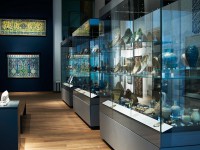Room 31 | Islamic Middle East gallery
Explore artefacts made over a period of more than 1000 years in the heart of the Islamic world.

‘That which has been evenly fired reflects like red gold and shines like the light of the sun.'
(From Abu'l Qasim's treatise on ceramics, about 1300)
From about 1170 to 1220, Iranian potters in the town of Kashan used the newly introduced ‘fritware' ceramic to make the most refined and sophisticated pottery yet seen in the Islamic world.
Their finely-made pots often copied the shapes of silver vessels. They were decorated with elaborate and detailed images painted in lustre - a technique in use in the Islamic world since the second half of the AD 800s - or with the newly developed method of overglaze enamel painting (mina'i). Lustre-decorated pottery was made at the same time in Raqqa and in other manufacturing centres of historic Syria.
 Dish with seated figure (EA1956.49)
Dish with seated figure (EA1956.49)
 Dish with seated figures and epigraphic decoration (EA1956.88)
Dish with seated figures and epigraphic decoration (EA1956.88)
 Bowl with human-faced sun (EA1978.2256)
Bowl with human-faced sun (EA1978.2256)
 Bowl with seated figures by a stream (EA1956.33)
Bowl with seated figures by a stream (EA1956.33)
 Saucer with lobed rim and bird (EA1978.2315)
Saucer with lobed rim and bird (EA1978.2315)
 Dish with vegetal or epigraphic decoration (EAX.3068)
Dish with vegetal or epigraphic decoration (EAX.3068)
 Jar with incised lustre band (EA1978.2249)
Jar with incised lustre band (EA1978.2249)
 Bowl with vegetal and epigraphic decoration (EA1978.2175)
Bowl with vegetal and epigraphic decoration (EA1978.2175)
 Bowl with riders in a landscape (EA1956.28)
Bowl with riders in a landscape (EA1956.28)
 Jar with epigraphic band and roundels enclosing the signs of the zodiac (EA1956.58)
Jar with epigraphic band and roundels enclosing the signs of the zodiac (EA1956.58)
Overglaze enamel painting (mina’i ware)
Enamel-painted wares are one of the achievements of Iranian potters of the late 1100s–early 1200s. Like lustre, this technique required two firings in order to fix the enamels (usually red and black) and the occasional gold. This process made the manufacture more expensive and the risk for the objects higher. To date, Kashan, Iran, is the only identified centre of production of these wares.
Notice
Objects may have since been removed or replaced from a gallery. Click into an individual object record to confirm whether or not an object is currently on display. Our object location data is usually updated on a monthly basis, so contact the Jameel Study Centre if you are planning to visit the museum to see a particular Eastern Art object.
© 2013 University of Oxford - Ashmolean Museum




